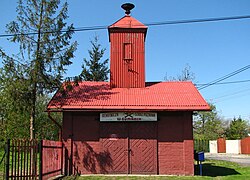Gumna
Gumna | |
|---|---|
Village | |
 Fire station | |
| Country | Poland |
| Voivodeship | Silesian |
| County | Cieszyn |
| Gmina | Dębowiec |
| First mentioned | 1523 |
| Area | 4.1 km2 (1.6 sq mi) |
| Population (2004) | 414 |
| • Density | 100/km2 (260/sq mi) |
| Time zone | UTC+1 (CET) |
| • Summer (DST) | UTC+2 (CEST) |
| Postal code | 43-426 |
| Car plates | SCI |
Gumna [ˈɡumna] is a village in Gmina Dębowiec, Cieszyn County, Silesian Voivodeship, southern Poland.[1] It has a population of 414 (2004). It lies in the Silesian Foothills and in the historical region of Cieszyn Silesia.
History
Archaeological traces of the first farmers in the area from Lengyel culture (4th millennia BC) have been found in the village.[2]
The village was first mentioned in 1523 as Humna.[3][4] Politically the village belonged then to the Duchy of Teschen, a fee of the Kingdom of Bohemia, which after 1526 became part of the Habsburg Monarchy.
After Revolutions of 1848 in the Austrian Empire a modern municipal division was introduced in the re-established Austrian Silesia. The village as a municipality was subscribed to the political and legal district of Cieszyn. According to the censuses conducted in 1880, 1890, 1900 and 1910 the population of the municipality dropped from 330 in 1880 to 312 in 1910 with a majority being native Polish-speakers (dropping from 100% in 1880 to 92.9% in 1910) accompanied by a German-speaking people (at most 22 or 7.1% in 1910). In terms of religion in 1910 majority were Protestants (56.1%), followed by Roman Catholics (41.3%) and Jews (8 or 2.6%).[5] The village was also traditionally inhabited by Cieszyn Vlachs, speaking Cieszyn Silesian dialect.
After World War I, fall of Austria-Hungary, Polish–Czechoslovak War and the division of Cieszyn Silesia in 1920, it became a part of Poland. It was then annexed by Nazi Germany at the beginning of World War II. After the war it was restored to Poland.
References
- ^ "Central Statistical Office (GUS) - TERYT (National Register of Territorial Land Apportionment Journal)" (in Polish). 2008-06-01.
- ^ Panic, Idzi (2012). Śląsk Cieszyński w czasach prehistorycznych (in Polish). Cieszyn: Starostwo Powiatowe w Cieszynie. p. 173. ISBN 978-83-926929-6-6.
{{cite book}}: Unknown parameter|trans_title=ignored (|trans-title=suggested) (help) - ^ Panic, Idzi (2010). Śląsk Cieszyński w średniowieczu (do 1528) (in Polish). Cieszyn: Starostwo Powiatowe w Cieszynie. p. 313. ISBN 978-83-926929-3-5.
{{cite book}}: Unknown parameter|trans_title=ignored (|trans-title=suggested) (help) - ^ Mrózek, Robert (1984). Nazwy miejscowe dawnego Śląska Cieszyńskiego (in Polish). Katowice: Uniwersytet Śląski w Katowicach. p. 75. ISSN 0208-6336.
{{cite book}}: Unknown parameter|trans_title=ignored (|trans-title=suggested) (help) - ^ Piątkowski, Kazimierz (1918). Stosunki narodowościowe w Księstwie Cieszyńskiem (in Polish). Cieszyn: Macierz Szkolna Księstwa Cieszyńskiego. pp. 264, 281.
49°46′24.31″N 18°41′26.02″E / 49.7734194°N 18.6905611°E


